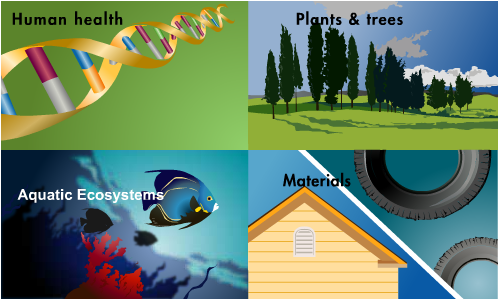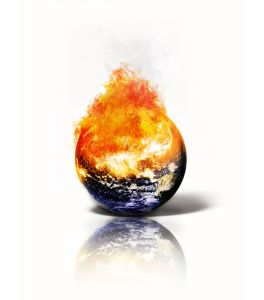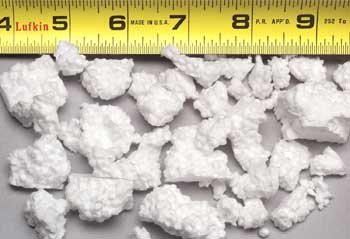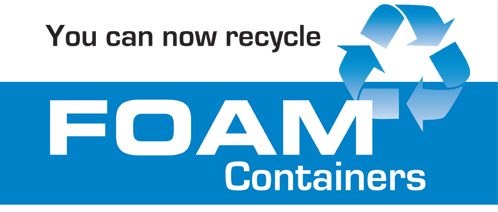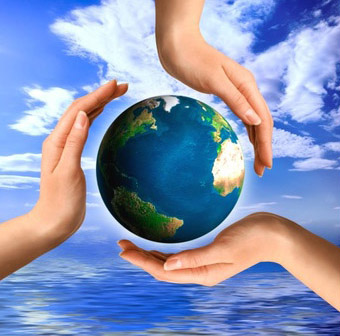| True or False? |
 |
 |
 |
|
Fallacy : The use of EPS is a tread to the ozone layer. Fact : The use of EPS has no effect on the ozone layer whatsoever.
Ozone gas forms a thin layer within the earth's stratosphere, which extends from approximately 15 to 50 kilometers above ground level. This ozone layer filters out much of the harmful ultraviolet (UV) radiation from the sun. Over the past decade, it has become well known that the family of chemicals known as chlorofluorocarbons (CFCs) has a depleting effect on this protective layer of ozone. As CFCs are relatively stable they can rise to the stratosphere where they break down to release chlorine atoms which can destroy many ozone molecules. STYROCELL does not use, and indeed has never used, CFCs at any stage in its production or use. The expansion agent for STYROCELL since it was first introduced in 1956 has been pentane, a simple hydrocarbon, which does not contain chlorine atoms and breaks down rapidly at low altitudes. Fallacy : The use of EPS makes a major contribution to the emission of man-made volatile organic compounds (VOCs). Fact : The use of EPS contributes only 0.2 percent to man-made VOCs.
This results from the gas pentane being released during the processing of EPS into finished goods, Pentane belongs to a chemical family (the alkanes) which includes the better known natural gases methane and ethane, as well as propane (LPG) and butane which are used as fuels for cooking, heating and transport, Much larger quantities of methane are released from the decomposition of household waste than pentane from the manufacture of EPS, Professor Hocking of the University of Victoria, Canada, has recently shown that the methane released from the decomposition of a standard paper drinking cup is 50 times higher than the amount of pentane released during the manufacture of an EPS drinking cup. Ref 1. Even larger quantities of VOCs are released from the buming of fossil fuels, or indeed from many natural processes, Nevertheless, industry is already engaged in work to reduce VOC emissions. Fallacy : The use of EPS contributes to global warming, the greenhouse effect and acid rain. Fact : The use of EPS as an effective insulating material and as lightweight packaging reduces the emissions which cause "global warming", the "greenhouse effect" and acid rain.
Certain so called "greenhouse gases", including water vapour, carbon dioxide and ozone, allow short-wave radiation to pass through them, but they absorb longwave radiation. The heat of the sun arrives in the form of short-wave radiation, which warms the earth. This heat is released in the form of long-wave radiation, which is then trapped in the atmosphere by these gases. Because this mechanism is similar to the way a garden greenhouse works, the phenomenon is known as the "greenhouse effect". Without this effect, the temperature of the earth would be about 30? lower. Too cold, in fact, to sustain human life. Over the last century, increased fossil fuel burning, agricultural activity and transportation has led to dramatic increases in the emission of some "greenhouse gases" Newer "greenhouse gases", such as CFCs, have added to this increase and there is widespread concern that the natural balance is being distorted and will lead to a greater retention of heat in the atmosphere. This has been called "global warming", and it has been calculated that unless emissions of greenhouse gases are reduced, the temperature at the earth's surface may rise. Carbon dioxide contributes as much to "global warming" as all other greenhouse gases put together. About 80 percent of carbon dioxide emissions are due to the buming of fossil fuels. The global output from this has trebled over the last forty years. Acid rain is principally caused by two groups of gases, sulphur oxides and nitrogen oxides. Power generation is a major source of sulphur oxides, while nitrogen oxides are a component of vehicle exhaust emissions. Once released, these gases dissolve in atmospheric moisture increasing its acidity. When this moisture falls as rain it can disrupt plant and animal life, most notably in forests and fresh water lakes. Scientists agree that the effective way to tackle these two issues is to reduce the emission of carbon dioxide and of sulphur- and nitrogen oxides. The most practical way of achieving this is to cut fossil fuel consumption through improved energy efficiency in heating and transport. EPS insulation contributes substantially to energy conservation in domestic and commercial buildings. Moreover, because EPS is durable, this benefit is sustained over many years. When used for transport packaging, this same insulation property, coupled with low weight, can lead to reduced fuel consumption and hence lower exhaust emissions. These savings far out-weigh the energy used in the manufacture and conversion of EPS into finished products. Consequently, EPS use leads to a significant net reduction in energy consumption. Fallacy : The manufacture and use of EPS poses a risk to health and the environment. Fact : The manufacture, conversion and use of STVROCELL poses no risk to health or the environment, providing standard product stelNardship practice is applied.
In its moulded form, STYROCELL foam typically comprises around 98% air. The remaining 2% is polystyrene. Styrene, the building block for polystyrene, has been manufactured on an industrial scale for more than 60 years. It can be found naturally in many foods, including strawberries, beans, nuts, beer, wine, coffee beans and cinnamon. Many studies have been conducted on the health effects of styrene, particularly links with cancer. Recently published studies, which traced 50,000 workers exposed to styrene over a 45-year period, showed no association between styrene and cancer. However, industry and governments have sponsored studies to provide further proof of safety. Research has indicated that environmental exposure due to the presence of styrene in ambient air (through car exhaust emissions, tobacco smoke etc.) is approximately 23 microgram per day. By comparison, estimated exposure due to presence in food (through natural occurrence and food packaging) is only about 5.5 microgram per day. This combined exposure is roughly 500-fold lower than the World Health Organisation guidelines of 16,000 microgram per day. Monitoring of styrene emissions in residential buildings under actual living conditions has shown that the use of EPS as an insulating material does not present a health risk. To further ensure that the EPS conversion process and the products made are safe, European manufacturers have pro-actively agreed to reduce the level of residual styrene in their products. In line with this, the STYROCELL manufacturing process ensures that at least 99.9% of the styrene is converted into polystyrene. The expansion agent used to create the foam structure of moulded polystyrene is pentane. Like other alkane gases, such as methane, pentane is continually being formed by natural processes such as in the digestive systems of animals and the anaerobic decomposition of plant matter by micro-organisms. Once released into the atmosphere, these gases are rapidly broken down. Workers in the plants and factories producing and converting EPS may come into contact with styrene and pentane, However, provided that good industrial hygiene practice is observed, exposure is well within stringent Intemational health and safety requirements for occupational exposure, A number of additives are incorporated into STYROCELL, Some increase moulding efficiency, which leads to energy savings and improved process economics, whilst others give fire retardancy to finished articles, often an important consideration when using EPS in construction, These additives are used in very small concentrations, All additives are carefully chosen to ensure that processing meets the most stringent operational health and environmental guidelines, STYROCELL grades intended for food contact comply with the compositional requirements of the major food regulatory regimes. Fallacy : EPS packaging is a major contributor to waste. Fact : EPS accounts for less than a tenth of one percent of the weight of municipal waste.
Most EPS packaging ends up in the municipal waste stream, which is the waste from homes and offices, In Europe, municipal waste accounts for approximately 5 percent of the total solid waste produced; the most prominent sources of the other 95 percent are agriculture and mining, The contribution made by all plastics to the municipal waste stream is approximately 7 to 7,5 percent by weight, less than glass or metals and Plastics in Municipal considerably less than paper. Many people think that because EPS is bulky, it is a major contributor to waste. If EPS waste is compacted with shredding and densifying equipment, it will be clearly seen that its contribution to waste is small - and also the cost of transporting it for recycling will be reduced. However, even although EPS makes a relatively small contribution to waste, recycling measures still need to be pursued. The plastics industry is actively working with national and local authorities and with consumers to develop environmentally and economically sensible policies for managing plastics waste. Fallacy : EPS waste cannot be reused or recycled. Fact : There are several lNaste management options available, including reduction at source, reuse, mechanical recycling, feedstock recycling, energy recovery and landfill.
The recycling technologies employed can be varied according to the quantity and composition of the waste collected. In this way waste management programmes can be tailored to suit local circumstances, such as the infrastructures for collecting waste and demand for recycled products. Recycling techniques must be chosen to maximise the value of the goods produced, whilst minimising the consumption of resources for transporting, sorting and cleaning the waste. Clearly, it is foolish to use methods which have a greater impact on the environment than can be justified by the value of the recycled end product. A brief guide to recycling techniques follows. Your local Shell Chemicals company can provide a list of companies and organisation involved in recycling in your area. Source reduction The smaller and lighter a disposable product is, the less waste there is in the end. For several years, EPS has benefited from better design and improvements in raw material performance, leading to reduced waste. Using EPS for packaging is a very effective way of protecting the goods being packed whilst minimising the weight of waste produced. Reuse EPS can be reused in many applications, such as multi-trip packaging for the internal transport of partially-assembled goods. However, since making EPS mouldings consumes very little energy, it is generally difficult to justify the cost and energy needed to collect, transport and clean EPS mouldings for reuse. A simple way to reuse this kind of EPS waste is to grind it and use it as a soil conditioner to improve drainage and aeration. EPS seed and pot-holding trays are often reused in this way at garden centres. Ground EPS waste is also used as a fill material in the manufacture of lightweight aggregates, including lightweight concrete, cellular brick and insulating plaster. Mechanical recycling The recycle value of most plastics is greatest if they are recovered free from contamination by other plastics, or other forms of waste. EPS is easily recognisable, and is generally used to package clean articles, such as electrical and electronic goods. This means it can be easily segregated from other materials before it enters the waste stream. Many countries have established labelling schemes which aid recognition and segregation of different plastics. Once separated, EPS waste can be ground and mixed with fresh EPS to make new foamed articles - this has always been used to reprocess the scrap produced during moulding. Altematively, EPS waste can be melted and extruded to make compact polystyrene, for items such as plant pots, coat hangers and wood substitutes or medium toughened polystyrene from which sheet for thermoformed articles such as trays can be made. As part of mixed plastic waste, EPS can be recycled to make, for example, park benches, fence posts and road signs, ensuring the plastic waste has a long and useful second life. Research and development by the plastics industry is continually improving handling methods, which will enhance the performance of products made from recycled EPS or mixed plastic waste, and make recycling more cost-effective. Feedstock recycling This involves breaking down the long molecular chains of plastics into products which can be reused in refinery or petrochemical processes. Shell companies have researched a thermal cracking process to convert long polymers into a residue oil stream, which can be reused as a feedstock for the Shell gasification process and other refinery processes. Although much work is being done by industry in this area, feedstock recycling technology is still in its infancy. Initial economic evaluations also show it to be relatively expensive, offering little impact on the total demand for crude oil. Energy recovery When mechanical recycling options have been exhausted, the energy content of EPS can be recovered to generate substantial amounts of energy. EPS has approximately the same calorific value as fuel oil. Incinerating waste and recovery of the energy released for generating electricity or for heating is an effective means of maximising the value of plastics as a resource. Energy recovery also has the advantage of being environmentally benign if appropriate control measures are used and disposal of slag is handled correctly. Even where energy is not recovered, the presence of EPS in the waste stream means less fuel will be needed to fire the incinerator, further adding to the attraction of this technology. Ref 7. Several countries, most notably Denmark and Switzerland, are already investing in the technology to recover energy. They are currently incinerating up to 80 per cent of municipal solid waste. Emission control systems have been developed to a standard where incineration plants can be run in these highly populated countries with no adverse effects on people or the surrounding environment. Landfill Contrary to popular opinion, landfill sites are not compost heaps, but are designed to be stable. If geologically suitable sites are available, landfill is still the cheapest and simplest way to dispose of solid waste in many countries. Well-managed sites can be reclaimed when full, and are stable enough not to suffer from subsidence, ground water contamination or the build-up of explosive gases resulting from decomposition. EPS is an ideal material for disposal in landfills, because it is mechanically stable and inert. However, in an integrated waste management programme, landfill should only be used as a last resort. Biodegradability and photodegradability A few years ago it was popularly thought that formulating plastics that could be broken down by micro-organisms, or under the influence of sunlight, would be a good solution to waste disposal. Unfortunately the degree of degradability achieved would be small in practice. Plastic buried in a landfill site will not easily photodegrade, and the conditions within landfills are so unsuitable for microbial activity that normally biodegradable materials, such as newspaper, can persist for years. Perhaps even more significantly, there is a risk that degradable plastics may disrupt the recycling process if they are inadvertently incorporated into a recycling scheme. Additionally, the performance of products made from these plastics could not be guaranteed. Fallacy : The use of EPS is an inefficient use of thw wrold's resources. Fact : To get a true picture of the environmental impact of any raw material, you need to add up all its effects from "cradle-to-grave", everything from how much energy it takes to manufacture to whether or not its components can be reused. When looked at in this way, EPS, compared with alternative materials, makes very efficient use of the world's resources.
Only 4% of commercially produced oil is used for the production of plastics, the rest is bumed as fuel and to generate power, Whilst this percentage is small, we must ensure it is put to effective use without damaging the environment. Eco-balance analysis or life cycle assessment, a new method of evaluating the environmental impact of products against common standards, has shown how important it is to ensure that judgements on environmental performance are based on all parts of the life cycle. This new discipline is the most effective method of environmental impact assessment available today and eco-balance analysis is becoming increasingly accepted as an important tool by EU and national authorities. Eco-balance analysis has two fundamental stages: firstly all the data relating to the production and use of a specific product is compiled. This inventory will include, for example, energy use and emissions at all stages of the products life cycle, from raw material acquisition and manufacture, to distribution, use and final disposal. In the second stage these data are used to compare the environmental performance of altemative products performing the same function or being used for similar applications. It is the most scientific way to compare one product with another, and to look for methods of improving the design, manufacture, use, or disposal of any product to reduce its environmental load. Of course, to make meaningful conclusions, the more subjective issue offitness-for-purpose must also be considered. If a product doesn't work well it is a wasted resource. The use of this eco-balance data may not therefore give a complete answer, but it does provide the essential guidelines for decision-making. Eco-balance analysis shows that abandoning plastics in packaging would not reduce the waste stream. A German study predicts that eliminating plastics from packaging and using paper, metal or glass replacements would increase the weight of packaging by 300 percent and the volume by 150 percent. Moreover, double the amount of energy would be consumed and the overall cost would be increased by 120 percent. It has also been shown that the replacement of loose fill EPS packaging with paper uses more energy and results in greater emissions to the atmosphere and water, even if the paper is recycled. Compared to polystyrene cups, paper cups consume about 15 times more chemicals, 13 times as much electricity, 170 times as much water and over twice their own weight in wood. When considering the environmental performance of EPS, it is often forgotten that about 60 percent is used in the construction industry as an insulating material and only enters the waste stream after a functional life span of more than 50 years. For every kilogramme of oil used to manufacture EPS insulation board, more than 150 kilogrammes will be saved through reduced demand for heating fuel over its lifetime. Ref 6. As an added benefit much of the energy content of the original oil used to make EPS could be released later during recycling. Moreover postconsumer packaging waste can and is being introduced into the production of new insulation products (5-25% by weight dependent upon application). It must be remembered that recycling is itself an industrial process. If the recycling uses more resources and energy than is worthwhile in terms of the value of the recycled materials produced, then it cannot be considered environmentally beneficial. Ecobalances can be used to assess when recycling is worthwhile. |







